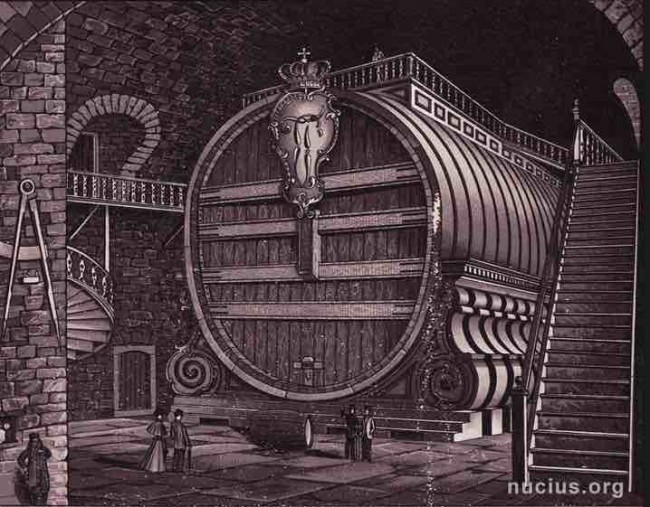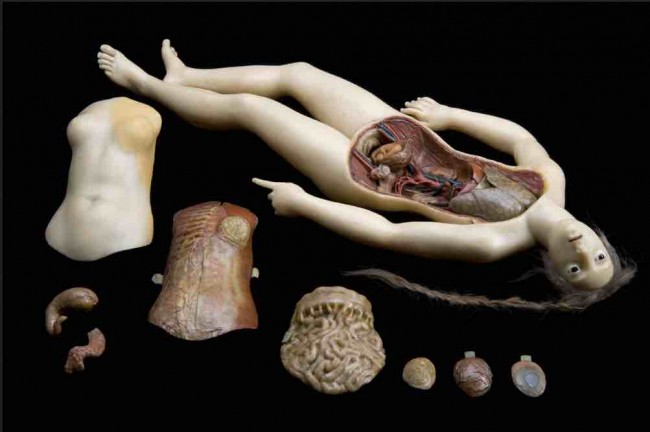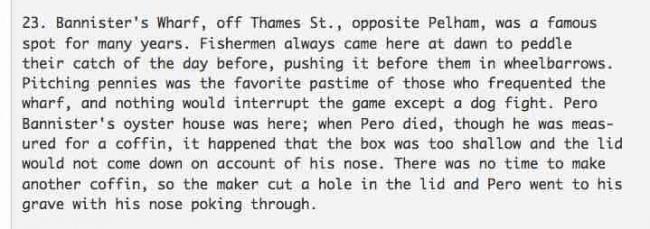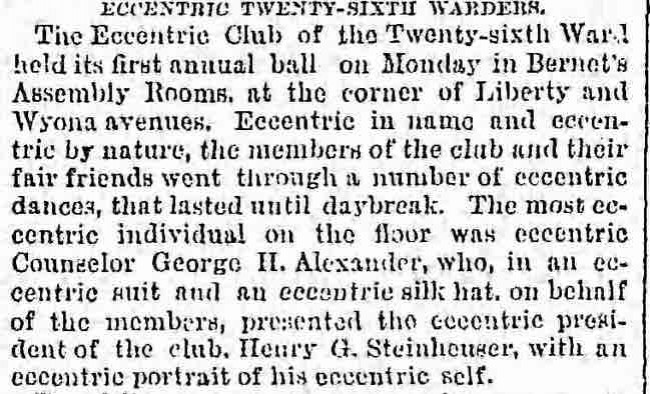Eighteenth Century
The Heidelberg Tun


Full story here.
Posted By: Paul - Wed Jun 22, 2016 -
Comments (5)
Category: Excess, Overkill, Hyperbole and Too Much Is Not Enough, Europe, Eighteenth Century, Alcohol
The Anatomical Venus

This new book about the "Anatomical Venus" looks to be fascinatingly weird. Lots more photos at the link.
Posted By: Paul - Sat May 21, 2016 -
Comments (2)
Category: Art, Body, Surgery, Women, Eighteenth Century
The Coffin of Pero Bannister
I find this anecdote in two sources. True, or apocryphal? You be the judge!
1880 text.

1937 text.
Posted By: Paul - Tue Mar 29, 2016 -
Comments (7)
Category: Death, Eighteenth Century, Nineteenth Century, Twentieth Century, Face and Facial Expressions, Head
The Eccentric Club
For over 230 years there has been one or more organizations known as "the Eccentric Club." I think every WU-vie should be a member by birthright.
Here is a tongue-in-cheek account of a party at an NYC branch from 1889.

Original article here.
Profile of the current London version.
Present-day USA version.
Posted By: Paul - Wed Nov 11, 2015 -
Comments (11)
Category: Eccentrics, Eighteenth Century, Nineteenth Century, Twentieth Century, Twenty-first Century
Lord Timothy Dexter

I just learned about a famous New England eccentric named Lord Timothy Dexter. People like this make me proud to be a Yankee.
Just one of his whimsicalities, from this write-up:
In 1798, Mr. Dexter returned to Newburyport, and August 15th of the same summer he bought the large house on High street that had been erected by Jonathan Jackson in 1771. Its situation is high, and commands an extensive view of the coast and the Isles of Shoals. The grounds were laid out by intelligent landscape gardeners. Everything about the house was in excellent order; but not to his wish. He raised minarets on the roof, and surmounted them with gilt balls. He caused it to assume a gaudiness and cheapness that was most undesirable to a person of taste.
Directly before the front door of the house, on a Roman arch, he erected a figure of Washington in his military garb, and on his left, a figure of Jefferson, and on his right one of Adams, the latter being hatless. On columns erected in the garden were figures of Indian chiefs, generals, philosophers, politicians, statesmen, and goddesses of Fame and Liberty. He changed the name of the statues by the aid of the painter's brush as he pleased. General Morgan was thus transformed into Bonaparte, and to the latter Dexter always touched his, hat. There were more than forty of these figures, including four lions, two couchant, and two passant. These images were of wood, life size, and fairly well carved. The lions were open-mouthed and looked fierce. The figures were made by a young ship carver who had just come to Newburyport, named Joseph Wilson, and were gaudily painted. The images were all in good condition when Dexter died, and the first to fall was an Indian. The remainder stood until the great September gale of 1815, when all but the presidents were cast prostrate upon the earth. The images were sold at auction, the specimen that brought the most money, five dollars, was the goddess of Fame. William Pitt was sold for a dollar, and the "Travelling Preacher," fifty cents. It is said that the arch and figures of the three presidents, all the presidents there had been in Dexter's day, cost at least two thousand dollars, the lions two hundred dollars apiece, and the other images a similar amount.
Posted By: Paul - Fri Jul 18, 2014 -
Comments (8)
Category: Eccentrics, Landscaping, Eighteenth Century, Nineteenth Century
Monkey Hangers
"Monkey hanger" is a term by which Hartlepudlians are often known. According to local folklore, the term originates from an incident in which a monkey was hanged in Hartlepool, England. During the Napoleonic Wars, a French ship of the type chasse marée was wrecked off the coast of Hartlepool. The only survivor was a monkey, allegedly wearing a French uniform to provide amusement for the crew. On finding the monkey, some locals decided to hold an impromptu trial on the beach; since the monkey was unable to answer their questions, and many locals were unaware of what a Frenchman might look like,[citation needed] they concluded that the monkey was in fact a French sailor. Being found guilty, the animal was duly sentenced to death and hanged on the beach. The vertical part of the ship's mast he was hanged from is still visible on the beach between the Pilot pier and the Heugh.
More here.
Posted By: Paul - Mon Mar 10, 2014 -
Comments (2)
Category: Animals, Death, Eighteenth Century
Having a child in a stagecoach
In 1709, the German legal scholar Dr. Heinrich Klüver published the following important work (which, amazingly, is available in its entirety on Google books): Kurtzes Bedencken über die juristische Frage: Ob eine schwangere Frau wenn sie wärender Reise auf dem Wagen eines Kindes genesen, für selbiges Fuhr-Lohn zu geben gehalten sey?Translation: Brief consideration of the judicial question: whether a pregnant woman, bearing a child while traveling in a stagecoach, is obliged to pay a fare for it or not.

Substitute Greyhound bus for stagecoach, and you have a question still relevant for present-day weird news scenarios.
Dr. Klüver's answer was: No, the woman doesn't have to pay an extra fare for the newly arrived baby.
His reasoning was that: 1) the baby wouldn't take up an extra seat if the mother held it in her lap.
And 2) The driver must have seen that the woman was pregnant when she boarded the coach, so he should have been aware of the possibility of her giving birth and charged her extra at that time, if he felt it was necessary.
Posted By: Alex - Fri Aug 09, 2013 -
Comments (3)
Category: Babies, Law, Eighteenth Century
A Strange Burial, 1736
From The History of Lymington, and its immediate vicinity, by David William Garrow (1825):"Samuel Baldwin, Esq. sojourner in this parish, was immersed without the Needles, sans ceremonie, May 20, 1736. It was ever his request, whilst living, that his body might be so disposed of after his death, from a superstitious notion that his wife, in the instance of her surviving him, would dance over his grave, actuated by a spirit of vindictiveness for his conjugal infidelity."

Lymington Parish Church
Update: "without the Needles" refers to a location — Needles Point.
Posted By: Alex - Mon Jan 21, 2013 -
Comments (9)
Category: Death, Obituaries, Eighteenth Century
Potemkin’s Bet
I recently picked up a copy of George Soloveytchik's biography of the eighteenth-century Russian statesman Grigory Potemkin
Posted By: Alex - Tue Jan 03, 2012 -
Comments (2)
Category: Politics, Scatology, Excrement, Eighteenth Century
Follies of the Mad Men #166
Ye Olde Colonial Hepcats. And that's "James Madison Avenue" to you!
Wait for second spot after the fadeout.
Posted By: Paul - Sat Nov 12, 2011 -
Comments (2)
Category: Business, Advertising, Products, Food, 1950s, Eighteenth Century

| Who We Are |
|---|
| Alex Boese Alex is the creator and curator of the Museum of Hoaxes. He's also the author of various weird, non-fiction, science-themed books such as Elephants on Acid and Psychedelic Apes. Paul Di Filippo Paul has been paid to put weird ideas into fictional form for over thirty years, in his career as a noted science fiction writer. He has recently begun blogging on many curious topics with three fellow writers at The Inferior 4+1. Contact Us |





